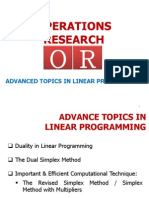Special Cases in Linear Programming
Uploaded by
Danna GodezSpecial Cases in Linear Programming
Uploaded by
Danna GodezINFEASIBILITY UNBOUNDEDNESS DEGENERACY ALTERNATE OPTIMAL SOLUTIONS
There exists no solution that satisfies all of the problems
constraints An infeasible solution would be apparent by looking at the final tableau Solution seems optimal but artificial variable(s) still exist in the solution mix Generally indicates an error in formulating the problem or in entering data Problems with no feasible solution do exist in practice, most often because managements expectations are too high or because too many restrictions have been placed on the problem Infeasibility is independent of the objective function (a change in the coefficients of the objective function will not help, the problem will remain infeasible)
Illustration:
= Subject to:
maxP
2x1 x1 x1 x1
+ + + ,
x2 x2 x2 x2
3 6 0
Standard Form:
= 2x1 + Subject to: x1 +
maxP
x2 x1 x2
+ 0S1 - MA1 + x2 + S1 = - S2 + A1 = x1 , X2
3 6 0
Cj
Solution Variables
Solution Values
Tableau 1 2 1
x1 x2
0 S1
0 S2
-M A1
0
-M
S1
A1 Zj Cj - Zj
3
6 -6M
1
1 -M 2+M
1
1 -M 1+M
1
0 0 0
0
-1 M -M
0
1 -M 0
Outgoing Row S1 3 / 1 = 3 A1 6 / 1 = 6
Cj
Solution Variables
Solution Values
Tableau 2 2 1
x1 x2
0 S1
0 S2
-M A1
2
-M
x1
A1 Zj Cj - Zj
3
3 6-3M
1
0 2 0
1
0 2 -1
1
-1 2+M -2-M
0
-1 M -M
0
1 -M 0
**Notice that Tableau2 is already optimal since there is no positive entry is present in the Cj Zj row. However, the solution is x1=3 and A1=3. Since the existence of an artificial variable in the solution makes the solution meaningless, this is not a real solution. In general, if the solution is optimal but there are artificial variables in the solution, the solution is infeasible.
Exists when the objective function can be made infinitely large
(small) without violating any constraints Unboundedness can be discovered prior to reaching the final tableau Values in the row value ratios are all negative or undefined (positive or undefined) in which case, no outgoing variable Generally indicates an error in data or in formulating the constraints or its omission Also termed as managerial utopia; however, this cannot occur in real-world problems A change in the objective function can cause a previously unbounded problem to become bounded, even though no changes have been made in the constraints
Illustration:
= 2x1 + x2 x1 Subject to: x2 x1 , x2
maxP
3 6 0
Standard Form:
= 2x1 + x2 + 0S1 Subject to: x1 - S1 x2 - S2 x1
maxP
+ + + ,
0S2 A1 A2 x2
- MA1 - MA2 = 3 = 6 0
Cj -M -M
Solution Solution
Tableau 1 1
-M
-M
Variables Values
x1
1 0 -M 2+M
x2
0 1 -M 1+M
S1
-1 0 M -M
S2
0 -1 M -M
A1
1 0 -M 0
A2
0 1 -M 0
A1 A1 Zj Cj - Zj
3 6 -9M
Outgoing Row A1 3 / 1 = 3 A1 6 / 0 =
Cj 2 -M
Solution Solution
Tableau 2 1
-M
-M
Variables Values
x1
1 0 2 0
x2
0 1 M 1+M
S1
-1 0 -2 2
S2
0 -1 M -M
A1
0 0 0 0
A2
0 1 -M 0
x1 A1 Zj Cj - Zj
3 6 6-6M
Outgoing Row A1 3 / 0 = A1 6 / 1 = 6
Cj 2 1
Solution Solution
Tableau 3 1
-M
-M
Variables Values
x1
1 0 2 0
x2
0 1 1 0
S1
-1 0 2 2
S2
0 -1 -1 1
A1
0 0 0 0
A2
0 0 0 0
x1 x1 Zj Cj - Zj
3 6 12
Outgoing Row A1 3 / -1 = -3 A1 6 / 0 = Notice that one row value is -3 and the other is undefined. This indicates that the most constrained point doesnt exist and that the solution is unbounded.
Degeneracy can be discovered during the computation for the
outgoing variable
Results
from a tie in the minimum positive (negative) replacement ratio for determining the outgoing variable choice can be made arbitrarily
The presence of degeneracy sometimes result to cycling Cycling - A sequence of pivots that goes through the same tableaus and repeats itself indefinitely In practice, degeneracy frequently occurs although cycling is
rare; computer programs generally have no difficulty reaching the optimum even when degeneracy occurs (LINDO, LPSBA)
Illustration:
= 2x1 + 3x2 Subject to: 3x1 + 2x2 x2 x1 + 2x2 x1 , x2
maxP
maxP
12 3 8 0
Standard Form:
= 2x1 + 3x2 + 0S1 + 0S2 + 0S3 Subject to: 3x1 + 2x2 + S1 = 12 x2 + S2 = 3 x1 + 2x2 + S3 = 8 x1 , x2 = 0
Cj 0 0 0
Solution
Solution
Variables
Values
S1 S2 S3 Zj Cj - Zj
12 3 8 0
Tableau 1 2 3 x1 x2 3 2 0 1 1 2 0 0 2 3
0 S1 1 0 0 0 0
0 S2 0 1 0 0 0
0 S3 0 0 1 0 0
Outgoing Row S1 12 / S2 3 / S3 8 /
2= 1= 2=
6 3 4
Cj 0 3 0
Solution Variables
Solution Values
S1 x2 S3 Zj Cj - Zj
6 3 2 9
Tableau 2 2 3 x1 x2 3 0 0 1 1 0 0 3 2 0
0 S1 1 0 0 0 0
0 S2 -2 1 -2 3 -3
0 S3 0 0 0 0 0
Outgoing Row
S1 6 / 3 = 2 S2 3 / 0 = S3 2 / 1 = 2
Cj 2 3 0
Solution Variables
Solution Values
x1 x2 S3 Zj Cj - Zj
2 3 0 13
Tableau 3 2 3 x1 x2 1 0 0 1 0 0 0 3 2 0
0 S1 1/3 0 - 1/3 2/3 - 2/3
0 S2 - 2/3 1 -1 1/3 1 2/3 -1 2/3
0 S3 0 0 0 0 0
Decision:
x1 = 2 x2 = 3 Zj = 13
Condition in which more than one solution is available for a
linear programming problem each of which maximize or minimize the objective function Indicated by a situation under which a non-basic variable in the final simplex tableau showing optimal solution has a net zero contribution at least one of the non-basic variable is zero in the Cj-Zj row We can discover the alternate solution by using the column of that non-basic variable as the pivot column to make another tableau In practice, this situation is generally good for the manager or decision maker for it means that several combinations of the decision variables are optimal and that the manager can select the most desirable optimal solution
Illustration:
= 1000x1 + 2000x2 Subject to: 3x1 + 2x2 2x1 + 4x2 x1 x1 , x2
maxP
maxP
18 20 5 0 + 0S3 = 18 = 20 = 5 0
Standard Form:
= 1000x1 + 2000x2 + 0S1 + 0S2 Subject to: 3x1 + 2x2 + S1 2x1 + 4x2 + S2 x1 + S3 x1 , x2
Cj 0 0 0
Solution Solution Variables Values
S1 S2 S3 Zj Cj - Zj
18 20 5 0
Tableau 1 1000 2000 x1 x2 3 2 2 4 1 0 0 0 1000 2000
0 S1 1 0 0 0 0
0 S2 0 1 0 0 0
0 S3 0 0 1 0 0
Outgoing Row S1 18 / S2 20 / S3 5 /
2= 4= 0=
9 5
Cj 0 2000 0
Solution Variables
Solution Values
S1 x2 S3 Zj Cj - Zj
8 5 5 10000
Tableau 2 1000 2000 x2 x1 2 0 1/2 1 1 0 1000 2000 0 0
0 S1 1 0 0 0 0
0 S2 - 1/2 1/4 0 500 -500
0 S3 0 0 1 0 0
**At
this point, we can see that we have already reached our final tableau, but notice that a non-basic variable (x1) not included in the solution mix has a value of zero at the Cj Zj row
Cj 0 2000 0
Solution Variables
Solution Values
S1 x2 S3 Zj Cj - Zj
8 5 5 10000
Tableau 2 1000 2000 x1 x2 2 0 1/2 1 1 0 1000 2000 0 0
0 S1 1 0 0 0 0
0 S2 - 1/2 1/4 0 500 -500
0 S3 0 0 1 0 0
Outgoing Row S1 8 / 2 = 4 x2 5 / 1/2 = 10 S3 5 / 1 = 5
We continue to make another tableau using the column on the non-basic variable with zero value as the pivot element to determine the alternative optimal solution.
Cj 1000 2000 0
Solution Variables
Solution Values
x1 x2 S3 Zj Cj - Zj
4 3 1 10000
Tableau 3 1000 2000 x1 x2 1 0 0 1 0 0 1000 2000 0 0
0 S1 1/2 -1/4 -1/2 0 0
0 S2 - 1/4 3/8 -1/4 500 -500
0 S3 0 0 1 0 0
Decision:
Solution in T2 Alternative Optimal Solution
x1 = 0 x2 = 5 Zj = 10,000
x1 = 4 x2 = 3 Zj = 10,000
You might also like
- Quantitative Techniques For Managerial DecisionsNo ratings yetQuantitative Techniques For Managerial Decisions3 pages
- Graphical Method of Solving Linear Programming Problem67% (3)Graphical Method of Solving Linear Programming Problem25 pages
- Statistical Analysis: Session 2: Measures of Central Tendency100% (1)Statistical Analysis: Session 2: Measures of Central Tendency41 pages
- Financial Statement and Ratio Analysis of Berger Paints Bangladesh LimitedNo ratings yetFinancial Statement and Ratio Analysis of Berger Paints Bangladesh Limited41 pages
- Mini Project of Project and Operations Research ManagementNo ratings yetMini Project of Project and Operations Research Management11 pages
- Provisions Relating To Default in Furnishing Returns Under GSTNo ratings yetProvisions Relating To Default in Furnishing Returns Under GST2 pages
- M2019HRM046 - Cipla - Performance Management AssignementNo ratings yetM2019HRM046 - Cipla - Performance Management Assignement11 pages
- Process Modelling N Digital ConvergenceNo ratings yetProcess Modelling N Digital Convergence22 pages
- Sequencing Problems Processing N Jobs Through 2 Machines Problem Example PDF100% (1)Sequencing Problems Processing N Jobs Through 2 Machines Problem Example PDF2 pages
- Job Description Template - Wipro - MBA 2020-Converted - CBUNo ratings yetJob Description Template - Wipro - MBA 2020-Converted - CBU2 pages
- Casestudy:-Indian Telecom War: Startup Reliance Takes On Leader Airtel in 4G ServicesNo ratings yetCasestudy:-Indian Telecom War: Startup Reliance Takes On Leader Airtel in 4G Services7 pages
- Linear Programming: The Graphical and Simplex MethodsNo ratings yetLinear Programming: The Graphical and Simplex Methods11 pages
- From Sweeny Electronics' Standpoint, What Difficulties Might Mike Mahoney's Performance Appraisal Practices Create?No ratings yetFrom Sweeny Electronics' Standpoint, What Difficulties Might Mike Mahoney's Performance Appraisal Practices Create?7 pages
- 3-3. How Do Porter's Competitive Forces Model, The Value Chain Model, Synergies, Core Competencies, and Network Economics Help Companies Develop Competitive Strategies Using Information Systems?100% (1)3-3. How Do Porter's Competitive Forces Model, The Value Chain Model, Synergies, Core Competencies, and Network Economics Help Companies Develop Competitive Strategies Using Information Systems?4 pages
- Case Study - The Case of The Un Balanced ScorecardNo ratings yetCase Study - The Case of The Un Balanced Scorecard15 pages
- Transportation and Assignment Problems NotesNo ratings yetTransportation and Assignment Problems Notes10 pages
- Nature of Investment Decisions: Capital Budgeting, or Capital Expenditure Decisions100% (2)Nature of Investment Decisions: Capital Budgeting, or Capital Expenditure Decisions49 pages
- Some Exceptional Cases in Graphical MethodNo ratings yetSome Exceptional Cases in Graphical Method6 pages
- The Study of Agency Problem in Surya Nepal Pvt. LTD.: Submitted by Aashma SunuwarNo ratings yetThe Study of Agency Problem in Surya Nepal Pvt. LTD.: Submitted by Aashma Sunuwar10 pages
- Basic Forecasting Programming MathematicalNo ratings yetBasic Forecasting Programming Mathematical27 pages
- Dual Simplex Method For Solving The PrimalNo ratings yetDual Simplex Method For Solving The Primal49 pages
- Sample Pages: Introduction To Business AnalyticsNo ratings yetSample Pages: Introduction To Business Analytics23 pages
- Progress in Nuclear Energy: Cláudio M.N.A. Pereira, Celso M.F. Lapa, Antônio C.A. Mol, André F. Da LuzNo ratings yetProgress in Nuclear Energy: Cláudio M.N.A. Pereira, Celso M.F. Lapa, Antônio C.A. Mol, André F. Da Luz5 pages
- Artificial Bee Colony Harmony Search and Bee Algorithms On Numerical OptimizationNo ratings yetArtificial Bee Colony Harmony Search and Bee Algorithms On Numerical Optimization6 pages
- ME4103 PM Tutorial 2 - PERT Charts - Part 1No ratings yetME4103 PM Tutorial 2 - PERT Charts - Part 118 pages
- Gezgin Satici Problemi Icin Sezgisel Metotlarin Performans AnaliziNo ratings yetGezgin Satici Problemi Icin Sezgisel Metotlarin Performans Analizi8 pages
- The Proposed Simplex Method For The Solution of Linear Programming ProblemsNo ratings yetThe Proposed Simplex Method For The Solution of Linear Programming Problems9 pages
- NLPQLY: An Easy-To-Use Fortran Implementation of A Sequential Quadratic Programming Algorithm - User's GuideNo ratings yetNLPQLY: An Easy-To-Use Fortran Implementation of A Sequential Quadratic Programming Algorithm - User's Guide11 pages
- Graphical Method of Solving Linear Programming ProblemGraphical Method of Solving Linear Programming Problem
- Statistical Analysis: Session 2: Measures of Central TendencyStatistical Analysis: Session 2: Measures of Central Tendency
- Financial Statement and Ratio Analysis of Berger Paints Bangladesh LimitedFinancial Statement and Ratio Analysis of Berger Paints Bangladesh Limited
- Mini Project of Project and Operations Research ManagementMini Project of Project and Operations Research Management
- Provisions Relating To Default in Furnishing Returns Under GSTProvisions Relating To Default in Furnishing Returns Under GST
- M2019HRM046 - Cipla - Performance Management AssignementM2019HRM046 - Cipla - Performance Management Assignement
- Sequencing Problems Processing N Jobs Through 2 Machines Problem Example PDFSequencing Problems Processing N Jobs Through 2 Machines Problem Example PDF
- Job Description Template - Wipro - MBA 2020-Converted - CBUJob Description Template - Wipro - MBA 2020-Converted - CBU
- Casestudy:-Indian Telecom War: Startup Reliance Takes On Leader Airtel in 4G ServicesCasestudy:-Indian Telecom War: Startup Reliance Takes On Leader Airtel in 4G Services
- Linear Programming: The Graphical and Simplex MethodsLinear Programming: The Graphical and Simplex Methods
- From Sweeny Electronics' Standpoint, What Difficulties Might Mike Mahoney's Performance Appraisal Practices Create?From Sweeny Electronics' Standpoint, What Difficulties Might Mike Mahoney's Performance Appraisal Practices Create?
- 3-3. How Do Porter's Competitive Forces Model, The Value Chain Model, Synergies, Core Competencies, and Network Economics Help Companies Develop Competitive Strategies Using Information Systems?3-3. How Do Porter's Competitive Forces Model, The Value Chain Model, Synergies, Core Competencies, and Network Economics Help Companies Develop Competitive Strategies Using Information Systems?
- Case Study - The Case of The Un Balanced ScorecardCase Study - The Case of The Un Balanced Scorecard
- Nature of Investment Decisions: Capital Budgeting, or Capital Expenditure DecisionsNature of Investment Decisions: Capital Budgeting, or Capital Expenditure Decisions
- The Study of Agency Problem in Surya Nepal Pvt. LTD.: Submitted by Aashma SunuwarThe Study of Agency Problem in Surya Nepal Pvt. LTD.: Submitted by Aashma Sunuwar
- Progress in Nuclear Energy: Cláudio M.N.A. Pereira, Celso M.F. Lapa, Antônio C.A. Mol, André F. Da LuzProgress in Nuclear Energy: Cláudio M.N.A. Pereira, Celso M.F. Lapa, Antônio C.A. Mol, André F. Da Luz
- Artificial Bee Colony Harmony Search and Bee Algorithms On Numerical OptimizationArtificial Bee Colony Harmony Search and Bee Algorithms On Numerical Optimization
- Gezgin Satici Problemi Icin Sezgisel Metotlarin Performans AnaliziGezgin Satici Problemi Icin Sezgisel Metotlarin Performans Analizi
- The Proposed Simplex Method For The Solution of Linear Programming ProblemsThe Proposed Simplex Method For The Solution of Linear Programming Problems
- NLPQLY: An Easy-To-Use Fortran Implementation of A Sequential Quadratic Programming Algorithm - User's GuideNLPQLY: An Easy-To-Use Fortran Implementation of A Sequential Quadratic Programming Algorithm - User's Guide

























































































